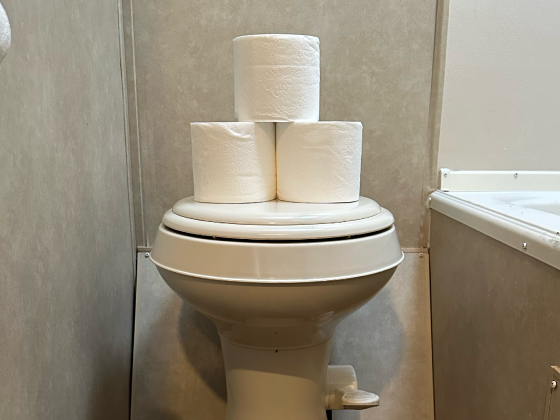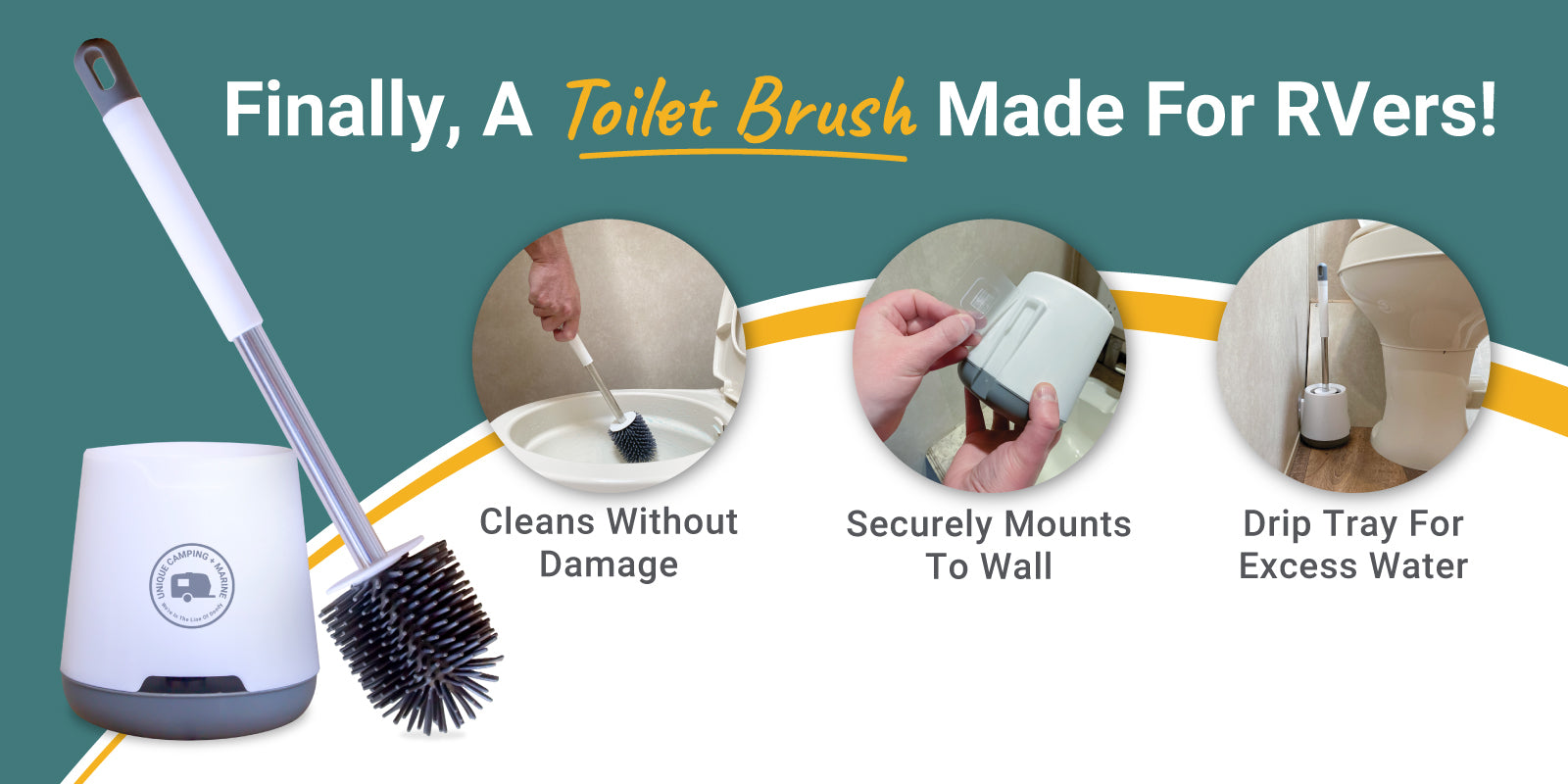As an Amazon Associate, Unique Camping + Marine earns from qualifying purchases.
View Printer Friendly Version.
Key Points:
- Black tanks should be deep cleaned at least twice a year to ensure continued functionality and odor-free RVs
- Gray tanks may need deep cleaning more often than twice a year depending on the type of camping you’re doing
- Deep cleaning black and gray tanks is easy and can happen while you sleep
- Deep cleaning wastewater tanks looks a little different for full-time RVers who must use their tanks while deep cleaning
- Common techniques and homemade treatment advice passed around the RVing community (The Geo Method, Borax, Ice and Driving, etc.) may not give you the results you want
We get a lot of questions about the best way to clean RV holding tanks. Keeping your holding tanks clean and free from build-up is key to avoiding the clogs and foul odors that can sneak into your RV. Without regular deep cleaning, waste can find ways to hide in the crevices and low points of your tank and potentially cause problems later when you’re thinking about anything but cleaning out your RV holding tanks. Whether you currently have a problem or just want to practice good tank care habits, deep cleaning your tanks is a great place to start.
If you think you might have a clog either in your tank or in your toilet right now, this guide will not help you remedy that problem. We recommend referring to the following guides that will help you diagnose the specific problem, how to fix that problem, and what you need to do going forward to avoid those same issues in the future:
Deep cleaning your black and gray holding tanks regularly is one of the ways to prevent future problems from arising at just the worst time. We’ll show you how easy it is to perform a deep cleaning with much less effort than you might suppose.
Deep Cleaning an RV Black Water Tank
Deep cleaning your RV black tank(s) may sound pretty involved, but it’s actually quite simple.
Supplies:
- Water
- A bacteria-based cleaner (like Clean-It)
- Time
We recommend using Unique Clean-It because it’s the strongest bacteria-based cleaner on the market and will help you achieve the deepest clean. The steps below will walk you through the process of deep cleaning your RV black tank using Unique Clean-It.
-
CLOSE YOUR BLACK TANK VALVE.
-
Fill your black tank with water.
This might sound obvious, but you can only clean what the water is touching, so the more water you add, the more your tank will be cleaned.
-
Dump 1 entire bottle of Unique Clean-It into your 40 gallon black tank by pouring it through your toilet and let it sit in the tank for 12-72 hours.
While Clean-It typically works in about 12 hours, the longer you let it work the better! Letting it sit for days, weeks, or even months won't cause any damage to your RV. Class B RVs and others with smaller tanks may need less than one bottle of Clean-It.
Note: No amount of Clean-It is too much, so feel free to use a whole bottle on a smaller tank or more on a larger tank. If you have questions, we are always willing to help you find the best solution for your RV.
-
Open your black tank valve and dump your tank.
-
Rinse your tank thoroughly.
-
If your RV comes with a built-in tank rinser (or flusher), it’s best to run it for about 30 minutes or until the tank is thoroughly rinsed out.
-
If you don't have a built-in rinser, we recommend using an RV holding tank cleaning wand or external tank rinser that connects to your discharge line.
-
-
CLOSE YOUR BLACK TANK VALVE.
Always keep your black tank valve closed unless you’re dumping!
It’s that simple! We recommend performing a deep clean on your black tank twice per year: once at the beginning of the RVing season and once at the end, or every 5-10 dumps for full-time RVers. If your RV is stationary and rarely moves, it's a good idea to perform a deep clean like this every 60 days since waste tends to accumulate because it never or rarely sloshes around. If this doesn’t solve the problem, feel free to contact us any time and we will try to help you solve the issue.
Modified Black Tank Deep Cleaning for Full Time RVers
If you are a full-time RVer, deep cleaning tanks can be a lot trickier when you’re trying to use them at the same time. We recommend that full-time campers clean their black tank(s) (every 5-10 dumps) regularly with Unique Clean-It (every 5-10 dumps) and their gray tank(s) with Dawn Ultra dish soap every week. This will help maintain properly working holding tanks and keep odors at bay.
We understand that while cleaning your black tank(s), you’ll still need to use them, so you may not be able to completely fill them with water and walk away for 2-3 days. Instead, full-time RVers should fill black tank(s) half or three quarters full with water (depending on anticipated usage), add one bottle of Clean-It per black tank (or less for smaller tanks), and continue regularly using your toilet, ideally letting the solution work for a full 72 hours before dumping. The best option is always to deep clean without using the tanks, but even deep cleaning while using them will still help prevent buildup and other tank issues. Just remember, Clean-It can only clean areas it can reach; areas of the tank walls that are not touched by water will not be cleaned.
Deep Cleaning an RV Gray Water Tank
If you think your black tank will likely be the only culprit when it comes to unpleasant smells inside your RV, consider the odors that could rise from the kitchen sink drain. Yes, your gray or galley tank(s) can easily start to stink as a result of the build-up of soap scum, food grease, lotions, or even human hair from the shower. This can cause more than just unpleasant odors; it can also lead to misreading sensors. Thankfully, because there aren’t a lot of solids inside your gray tank (at least, there shouldn’t be), restoring your gray tank to its full glory is very easy to do; just remove the grease that has built up inside the tank!
Note: To prevent solid food waste from getting into your gray/galley tank(s), use a sink strainer to catch residual food waste and wipe grease and debris off your dishes before washing whenever possible.
Supplies:
- Water
- Grease-eating dish soap
- Time
From our experience with customers, the best product out there for removing gray tank grease residue is Dawn Ultra dish soap. Yeah, we know; it doesn’t seem to make sense to add more soap to a gray tank that is already coated in soap scum and grease, but it’s an awesome grease eater and doesn’t leave a residue layer like other soaps. And just like deep cleaning the black tank(s), you can let the cleaning product (Dawn Ultra dish soap) do the heavy-lifting overnight while you sleep. The steps below will walk you through the process of deep cleaning your RV gray tank using Dawn Ultra dish soap.
-
Close your gray tank valve.
-
Fill your gray tank all the way to the top with fresh water.
The ultimate goal here is for water to cover all the areas you want cleaned. If your tank isn’t totally full, only the parts of the tank at or below the waterline will be cleaned. If you’re looking to restore your gray tank sensors, be sure that water covers the highest sensor in your gray tank.
-
Pour at least 20 ounces (or more) of Dawn Ultra dish soap down your RV’s kitchen sink.
There is no amount of Dawn Ultra that is too much. It’s possible that you’ll see it foaming back out of your sink or shower lines (an indication you’ve poured enough Dawn Ultra into the tank), which is a good sign because it means that the grease-eating dish soap is spreading throughout your RV’s pipes and cleaning out all the built-up residue.
-
Let Dawn Ultra sit in the tank and lines overnight.
-
Open your gray tank valve in the morning and empty your gray tank.
It’s very likely that you’ll see a grayish-white residue on the bottom of your holding tank discharge pipe. This is literally the grease that was previously clinging to the inside walls of your holding tank.
-
Rinse your tank very well by filling it completely and dumping it several times.
-
Repeat these steps if necessary.
Sometimes it can take several cleanings before the gray tank is completely spotless inside.
Like black tanks, it’s a good idea to deep clean your gray tanks on a regular schedule, depending on what kind of camping you are typically doing.
- If you are primarily a hookup camper (and you follow our advice about gray tank valves), we recommend deep cleaning your gray tank biannually, once at the beginning of the season and once at the end.
- If you are a boondocker (dry camper), we recommend you perform a deep clean like this on the last night of every camping trip to avoid grease buildup inside your gray tank.
Routine cleaning of both your black and gray/galley tanks will help you stay on top of any waste and grease buildup that can cause your tanks to smell or your sensors to misread. If your sensors are currently misreading and you’re in need of specific guidance for restoring your tank sensors, refer to the How to Clean and Restore RV Wastewater Sensors guide.
Deep Cleaning an RV Black/Gray Water Combo Tank
Combo tanks can sometimes be more challenging to clean if you are using it as both a black and grey water tank. Some RVers stick to using it for only grey water or only black water. Here are a few tips about how to clean your combo tank based on how you are using it:
-
If you are using your combo tank as only a black water tank, refer to the steps in the Deep Cleaning an RV Black Water Tank section above.
-
If you are using your combo tank as only a gray water or galley tank, refer to the steps in the Deep Cleaning an RV Gray Water Tank section above.
-
If you are using your combo tank for both gray and black water, start by cleaning it as if it were solely used as a black tank. If you think there may be ample amounts of grease or soap scum still there that were not taken care of by the black tank cleaning steps, use the gray tank cleaning steps as well.
Combo tanks aren’t hard to keep clean and if in doubt, start by using the black tank cleaning steps and then follow up with a gray tank cleaning. Never hurts to clean both ways and cover all bases.
Common Tank Care Advice in the RVing Community
Deep cleaning your wastewater tanks should never be frustrating or labor-heavy, but it is easy to get stressed out when trying to choose the best way to deep clean your tanks because there are so many different opinions on the subject. The RVing community shares a lot of home remedies and commonly used methods to deep clean RV holding tanks, but often that advice does not pan out as well as you might think. If you are considering using some of the deep cleaning advice passed around by other RVers, we encourage you to read our article on Common RV Holding Tank Myths Debunked; the results of many of the techniques and recommended products fall short of the praise they receive.
The Unique Method will help prevent the majority of tank problems before they happen, so we recommend following this method, which recommends regular deep cleaning. For more thorough details on full-time RVing care habits, refer to Full Time RVing: The Definitive Guide To Treating Your Tank.
Review
Deep cleaning both your black and gray tanks will not only help you enjoy your RVing adventure all the more without having to deal with nasty odors or the probability of RV clogs, but it will also help your wastewater systems run optimally for years to come. Here’s a brief review of what we covered in this guide:
- Deep cleaning your RV wastewater tanks regularly is very important for avoiding clogs and odors in the future
- Steps for deep cleaning black water tanks
- Steps for deep cleaning gray/galley tanks
- Modified deep cleaning techniques for full-time RVers

Prevent Common Problems In Your Tanks!
From misreading sensors, preventing clogs, or eliminating odors, we've got you covered no matter how you camp! All our best holding tank tips and trick information plus more can be found conveniently in one place when you download our FREE Unique Method Field Guide. Achieve holding tank bliss today!
Get The Free Download



